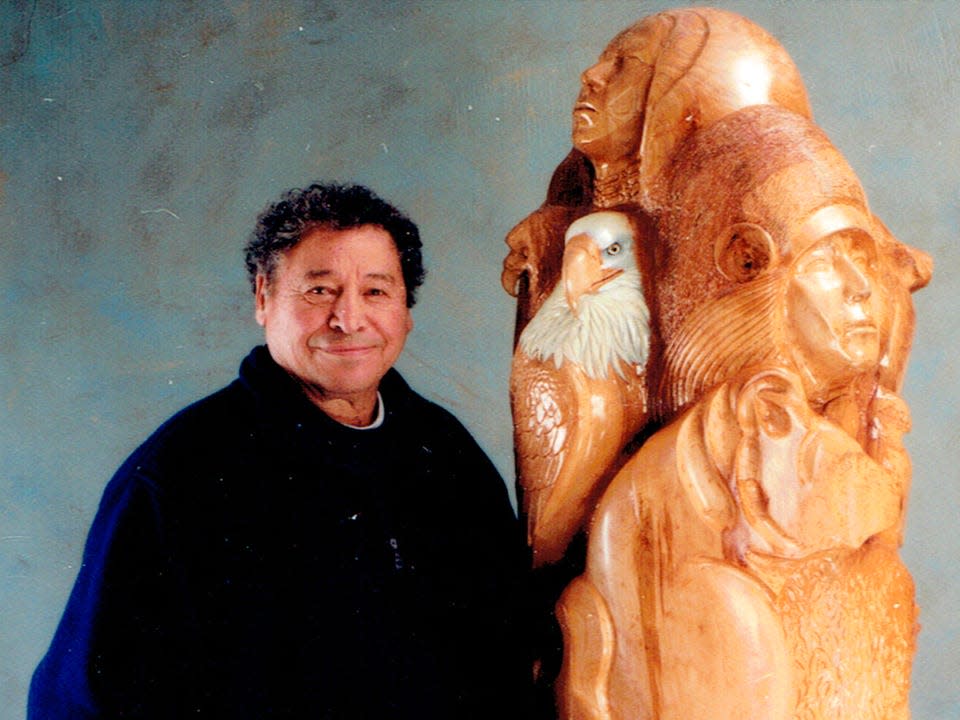Ho-Chunk artist, Wisconsin native Harry Whitehorse honored with wood sculpture festival

MONONA - Chainsaws whirred in San Damiano park on the shores of Lake Monona Thursday, but they weren't cutting down trees.
They were bringing old logs to life.
The park, which sits on the ancestral lands of the Ho-Chunk Nation near the border of the cities of Madison and Monona, played host last week to 11 wood sculpture artists from around the world. They were there for the inaugural Harry Whitehorse International Wood Sculpture Festival, honoring the work and the spirit of local Ho-Chunk artist Harry Whitehorse.
A Monona resident who passed away in 2017, Whitehorse left his mark on the Madison area with 10 of his sculptures depicting his heritage and his love for the natural world.

Decades earlier, Whitehorse began mentoring Gene Delcourt, then a graduate student at the University of Wisconsin-Madison, on his wood sculpting craft. He encouraged Delcourt, who is Abenaki and Filipino, to attend symposiums in Europe dedicated to the art form. Each time Delcourt returned from a symposium, he thought, "I'd really love to put one of these on."
Last week, his dream of a festival honoring his mentor and friend was achieved — the first international festival dedicated to an Indigenous person, he said. Even the rainy weather couldn't dampen his perspective on it.
More: Ho-Chunk language being revitalized through new app
"It couldn't have been more perfect," Delcourt said. "I know when it's over, I'm going to be so sad."
On Thursday, artists from Peru, Germany, the Czech Republic, Ghana, Switzerland, India, Poland and Wisconsin whittled, chiseled and sawed under handcrafted wigwam structures as curious members of the public watched from a safe distance. They arrived June 14 to select their logs, which Delcourt solicited from a number of local tree services, and stayed with community members during their week in residence.

Lidia Rosińska, of Zakopane, Poland, was finishing up her piece depicting a woman wearing a dress of flowers and leaves, carved from red oak, in line with the festival's theme of nature and the environment. Inset on the wood were ceramic bees, meant to evoke Albert Einstein's quote, “If the bee disappeared off the surface of the globe, then man would have only four years of life left."
Rosińska, who was visiting the U.S. for the first time, said it's important to her that art not be just for show, but also for educating the public. It's part of why she enjoys attending events like the festival, she said, so people get the chance to see the artists work on a piece from start to finish.
"In the gallery, you can see only the finish," she said.
Deb Whitehorse, Harry's wife, said from the moment chainsaws fired up last weekend, the art being created was fluid, shifting shapes hour by hour. She called wood an "honest" material, recalling stories her husband told her about crafting bows and arrows with it as a kid. One of the goals of the festival was to elevate wood sculpture to encourage more Indigenous artists to give it a try.

When Delcourt told his faculty committee in graduate school that he wanted to carve wood, they were surprised and somewhat dismissive, he recalled. It wasn't until he connected with Whitehorse, visiting his house and carving small birds together, and eventually traveling internationally to symposiums, that he saw others valuing the art form.
Delcourt carved a large wooden sculpture that now stands in front of the casino in Lac du Flambeau. It depicts all the clan animals of the Ojibwe tribes. He remembers how meaningful it was to have Whitehorse compliment him on it.
"The best I could hope for was him saying, 'Oh, that's good,'" Delcourt said. "And he said that."
During the festival, Delcourt was working on a piece calling attention to the crisis of missing and murdered Indigenous women across the U.S. and Canada. Indigenous women and girls face higher than average rates of violence, data show, but such cases often go unsolved. After carving a woman's features into basswood, he planned to place a red handprint over her mouth, a symbol of the movement to bring Indigenous women justice.
He said Olbrich Botanical Gardens has asked to display it and four other sculptures from the festival for the next year.
In addition to the wood carving, the nine-day festival included cultural presentations such as finger weaving, bead art and basketry, as well as live music. Its Saturday closing ceremony culminated in a potluck for the artists and the public.
Festival founders plan to host it again in two years, Deb Whitehorse said, to give themselves more time to help artists from different parts of the globe procure visas.
Public support for the festival has been high, which she said was humbling. "I think everybody's feeling that this is not only our event, but the whole community's."
Madeline Heim is a Report for America corps reporter who writes about environmental issues in the Mississippi River watershed and across Wisconsin. Contact her at 920-996-7266 or mheim@gannett.com.
This article originally appeared on Milwaukee Journal Sentinel: Wood sculpture festival pays homage to the work of a Ho-Chunk artist

